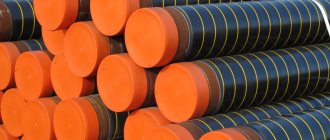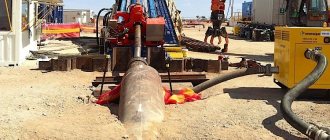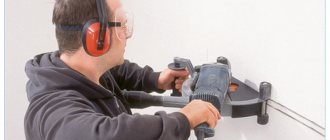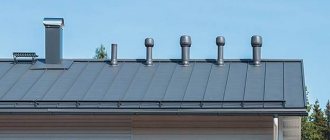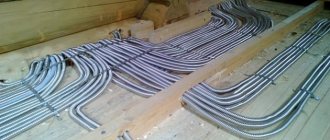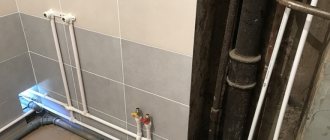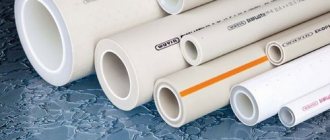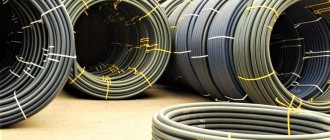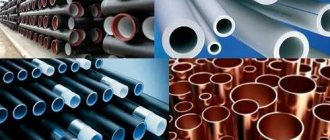Communications are currently carried out using modern technologies. Steel pipes have been replaced by HDPE pipes, which are used to lay water pipes in the ground. The first type is recognized as one of the best, having thermal expansion and affordability. However, it has the following disadvantages:
- Low corrosion resistance;
- Action of the chemical environment;
- Limited in length;
- Considerable weight;
- The installation process is labor intensive;
- Short service life compared to other types (10-15 years)
Considering all the above weaknesses, the mass market has switched to products made of plastic.
Features, pros and cons of HDPE pipes
HDPE (low-density polyethylene) is a modern, high-quality polymer, products from which are in great demand in the construction of utility networks.
Appearance of products
The main positive characteristics of polyethylene products include:
- ability to withstand increased internal pressure (depending on the parameters of the assortment - up to 10 MPa);
- low density of the material and therefore low weight of the product;
- resistance to expansion under the influence of heat (no more than 3% at maximum permissible temperatures);
- lack of response to exposure to chemically active substances and reagents;
- relatively low price;
- long service life - up to 50 years.
The disadvantage of polyethylene products is the limited range of operating temperatures: from 0 to 40°C.
At low temperatures, pipes become brittle, which can lead to pipe failure.
Repair of a failed polyethylene pipe
*
Under the influence of high ambient temperatures, the opposite phenomenon occurs - the material softens and loses the necessary operational rigidity.
This drawback makes the use of polymer pipes undesirable in open areas and puts forward the requirement that they be laid in the ground below the freezing point or with insulation.
Assembly on compression (crimp) fittings
An entire system is installed on one or two sides of the fitting (sometimes on three) to ensure the connection. The fitting itself consists of:
- housings;
- clamping nut;
- collets - a plastic ring with an oblique cut that provides a tight fit around the pipe;
- thrust ring;
- gaskets, which are responsible for tightness.
How reliable is the connection?
Despite the apparent unreliability, the connection of polyethylene pipes with compression fittings is reliable. Properly made, it can withstand operating pressures of up to 10 atm and higher (if these are products from a normal manufacturer). Watch the video for proof.
This system is good because it is easy to install yourself. You probably already appreciated this from the video. Simply insert the pipe and tighten the thread.
Summer residents, in addition to the opportunity to do everything with their own lessons, like it because, if necessary, everything can be disassembled, hidden for the winter, and put back together again in the spring. This is in case the wiring is made for irrigation. The dismountable system is also good because you can always tighten the undercut fitting or replace it with a new one. The disadvantage is that the fittings are bulky and internal wiring in a house or apartment is rarely made from them - the appearance is not the most pleasant. But for the water supply section - from the well to the house - it is difficult to find better material.
Assembly order
The pipe is cut strictly at 90°. The cut should be smooth, without burrs. There should also be no dirt, oil or other contaminants present. Before assembly, the sections of the joined sections are chamfered. This is necessary so that the sharp edge of the polyethylene does not damage the rubber sealing ring.
The spare parts are put on the prepared pipe in this order: the crimp nut is tightened, then the collet, then the thrust ring. We install the rubber gasket into the fitting body. Now we connect the body and the pipe with the parts put on it, applying force - you need to insert it all the way. We pull all the spare parts to the body and connect them using a crimp nut. Tighten the resulting connection of polyethylene pipes with force by hand. For reliability, you can tighten it with a special mounting key. It is not advisable to use other tools for tightening: the plastic may be damaged.
How to prepare a trench for laying a highway
Having put the communication construction plan on paper, you can begin its practical implementation.
Work on laying a route of HDPE pipes in the ground begins with the equipment of a trench.
In this case, the following conditions must be met:
- the depth of the trench should be such that communications lie at least 0.5 m below the soil freezing level;
- At the bottom of the trench, a cushion of sand is installed (in hard soil) or backfilled with fine gravel (on loose soils).
Such a cushion not only levels the bottom of the trench, but also protects the highway from deformation under load.
Sand cushion in a trench
It is not recommended to lay polyethylene sewerage at a depth of more than 2.5 m.
Step-by-step algorithm for constructing a trench:
- Marking, according to the plan, the pipeline route along the cord;
- Excavation (manually or using special equipment).
- Preparation of the bottom of the route (compaction and cushion equipment).
The technology for laying HDPE pipes during the construction of sewer systems assumes, as a general rule, a slope of 1-2 degrees per meter of length.
Maintaining the angle of inclination at the trench digging stage
The width of the trench is selected taking into account the ease of installation work.
Varieties of elements
Fittings for assembling individual elements into a single conductive network come in several types. They are usually made of polyethylene, but they are also made of brass. Based on their purpose, they can be divided into several categories:
- Connecting HDPE pipes of the same diameter with compression fittings
- Assembly of pipelines from conductive sections of different sections
- Creation of branches in accordance with the general pipeline diagram
- Joining of HDPE pipes with different types of fittings
- Performing a highway turn
- Installing the plug
Most often, these connecting elements are used when creating collapsible structures , but there is a variety used when creating a solid pipeline - an electric or welded fitting.
According to their design features and scope of application, docking components can be divided into several types:
- Couplings for connecting HDPE pipes. They, in turn, come in three main categories: equal-bore, for sections of the same cross-section, flanged, for thick water flows, and compensating, for connecting mains of different diameters.
- Bends . This design is used to form pipeline turns.
- Adapters. They are used to connect various fittings or a section made of another material: cast iron, metal.
- Tees and crosses . Serve to create branches of the conductive network.
- Stubs . They are used to shut off liquid or gas entering the system.
Each type of this device is designed for a separate type of piping system.
How to properly lay pipes in the ground
*
Installation begins from the point of water or wastewater intake. The prepared material is pre-laid along the edge of the trench.
In pipes with a socket, it is important to choose the correct direction of the socket - opposite to the drain.
The further installation process is as follows:
- cleaning of bells and joints;
- marking the maximum depth of the pipe entry into the socket;
- joining the end of one pipe to the socket of another, but not all the way - with a mandatory gap of 1 cm.
You need to focus on the mark you made. Such a gap is necessary to compensate for spontaneous deformations of the route.
When constructing communications from polyethylene at a depth close to the freezing point, it is necessary to insulate it. When using the trench installation method, foamed polyethylene is often used for insulation.
Insulation for HDPE communications
This insulation has excellent thermal insulation and vapor permeability properties, has good density and elasticity.
How to seal pipe connections
The tightness of the HDPE pipe system is ensured using rubber seals. When laying an underground pipeline, it is necessary to ensure its additional sealing at the socket joints. This is dictated by the difficulties in identifying a malfunction and repairing the system in the event of leaks or groundwater entering it.
Silicone sealing
Polymer sealants are used to seal joints. The most popular of them is silicone, which contains rubber. In working condition, this material has good elasticity, a high degree of adhesion and can withstand heavy loads.
On the market you can choose a sealant for specific operating conditions of sewer or water supply systems.
Sealing pipes with silicone
*
The compound is applied without gaps to the inside of the socket and the outer section of the pipe being joined to it, and after the connection it is necessary to lay the sealant around the entire circumference and to the outer part of the joint. The seam is smoothed with a soft spatula or a moistened gloved finger.
Important! After joining the pipes with silicone sealant, it is necessary to ensure that the joint areas remain motionless for at least 4-6 hours.
Sealing with self-adhesive tape
Self-adhesive tape is effective for sealing pipeline turning corners, plugs, taps or bends. Its composition includes bitumen-polymer materials, which ensures complete waterproofness.
Working with tape is easy:
- Prepare areas of pipe connections by cleaning them from dirt and treating them with a primer.
- Wind the tape under constant tension with a 50% overlap over the joint area, avoiding folds and distortions.
The tape is applied to a dry surface with a mastic layer inward in a spiral.
Sealing self-adhesive tape
Advantages of sealing tape:
- long service life with preservation of tightness - more than 30 years;
- avoiding deformation when applied correctly;
- mechanical strength and resistance to chemicals and soil corrosion.
To seal the communication route in the ground, it is better to use winter tape with the letter “Z” in the marking.
Why is thermal insulation needed?
Insulation of pipes is a necessary condition for their proper operation. If for some reason you were unable to install the pipeline at a depth of 1.4-1.6 meters, then thermal insulation will protect the fittings from low-temperature damage.
Important! Even if your region has warm, mild winters, you should not neglect thermal insulation. It is impossible to predict weather anomalies, and a sudden frost can cause a serious accident on the pipeline.
Mineral wool in rolls is used as thermal insulation for pipes, as well as special covers made of foamed polystyrene, polystyrene foam and rubber, which are placed over the pipes before welding. Insulating materials can also be supplied in the form of so-called. a shell consisting of two halves of a circle. When installing such insulation, it is fixed with special tape.
Pipe connection methods
*
The HDPE pipeline can be installed in detachable and permanent ways.
Detachable method
This is the simplest option for pipe connections. It involves socket or fitting pairing.
Special elastic seals are used for fastening into the socket. This method does not provide 100% tightness, so it is used in the construction of non-pressure networks.
A more reliable way to install a polyethylene line is using fittings.
Connecting pipes with fittings
Compression fittings are used when installing pipes of small diameters - up to 63 mm.
Required accessories for detachable installation:
- metal hacksaw or pruning knife;
- calibrator or sandpaper - for chamfering;
- mounting key for HDPE fittings;
- manual or electric press pliers.
For professional work, you can buy more expensive equipment - a manual hydraulic press.
One-piece method
Larger diameter pipes are welded: butt welded or using electric couplings.
For butt welding, pipes are placed in a special apparatus, which fixes them and then heats them, bringing the ends to a viscous state. After which they are pressed with force and welded to each other.
Electrofusion welding is performed using special connectors and is not very difficult. A low-temperature electric spiral is mounted inside the shaped elements, which heats up under voltage and welds the couplings.
Electrofusion welding
To weld HDPE pipes, a special machine is required. Such compact machines are not cheap equipment and are usually used by professional craftsmen. Purchasing a welding unit for one-time work is not rational.
The welding method allows for installation of the route in cramped conditions.
Options for creating nodes
Considering that polyethylene is very different in its characteristics from its analogues, the installation of such systems is carried out using other methods. So, there are three technologies for joining HDPE pipes:
- One-piece, which involves welding pipeline parts.
- A detachable connection, the main fastening element of which is a flange.
- Collapsible, in which pipe fragments are connected with compression fittings.
When choosing the optimal pipeline installation option, several main points are taken into account:
- media type;
- conditions for laying and operating the highway;
- building codes and requirements.
The connection method using fittings is suitable for lines consisting of collectors with a small internal diameter. Typically, joining parts using this method is carried out in non-critical areas of water supply networks.
The welding joining method is used to implement engineering projects of any complexity. In this case, the type of media and the size of the highway do not matter. The only exceptions are cases when it is necessary to connect the HDPE manifold with a metal pipe or a pipe made of another polymer.
Flanged detachable joining is practiced on pipelines with a diameter of 50 cm or more (water pipelines, gas pipelines). Flanges can also be installed when connecting shut-off valves to the pipeline, which allows you to regulate the movement of the carrier in the system.
According to the requirements and building codes, underground pipelines made of HDPE materials must be installed using the welding method. Collapsible joints on the line are arranged in the form of separate installations - water wells.
Regulatory requirements SNiP
SNiP requirements for the width of a trench for laying pipes with a diameter of up to 0.5 m are as follows:
| Type of connection | Trench width |
| Welded | D+0.5 m (D - pipe diameter) |
| Bell-shaped | D+0.6 m |
| Flanged | D+0.8 m |
*
For the installation of HDPE pipes, SNiP has established:
- welding work cannot be carried out at temperatures below 10°C;
- It is necessary to protect the welding area from rain, dust and dirt.
It is prohibited to weld pipes and couplings made of different materials.
Marking
A colored stripe along the entire length informs about the substances for which the pipes will be used.
A blue stripe is applied to them for water pipes, a yellow stripe for gas pipes.
The outer surface of the products must contain markings containing information about the manufacturer, characteristics and scope of use.
At the beginning, the name of the manufacturer is given, then information about technical and operational parameters (product name, brand of raw materials, SDR, outer diameter and wall thickness (mm), operating pressure (MPa), production date, purpose (drinking, technical).
Since domestic products are manufactured in accordance with GOST 18599-2001 , its number is indicated. In addition, the batch number may be indicated.
Number, SDR and GOST according to the marking of HDPE pipes
Dimensions
For artesian wells, large diameter pipes are produced in a special range of standard sizes - diameter 75-180 mm with wall thickness from 7.1 to 16.4 mm. The dimensions determine their working pressure, it is 5-16 MPa.
The diameters of HDPE pipes comply with international standards ISO 161-1.1996. Products manufactured in Russia have standard sizes in accordance with GOST 18599-2001, according to which the pipe diameter is from 16 to 200 mm (with a wall thickness from 1.5 to 14.6 mm).
The length depends on the diameter. The flexibility of HDPE pipes of small diameters allows them to be laid after manufacturing in coils, convenient for storage and transportation. Pressure pipes of small diameters (25-50 mm) are usually produced and laid in coils of 500 m. Variants of larger diameter (63-110 mm) are produced and laid in coils of 200 m. In diameters from 110 to 1600 mm, they are supplied in lengths of 12 and 6 meters.
SDR Ratio Value
S - series, belonging to a certain strength class. An important characteristic is the ratio of the outer diameter of the HDPE pipe to the thickness of its walls SDR description - ( Standard Dimension Ratio ), which determines the maximum pressure on the walls .
The lower the SDR, the higher the pressure the pipe can withstand. SDR = D/S, where D is the diameter and S is the wall thickness. SDR depends on the S series: SDR= 2S + 1, where S corresponds to the pipe sizes according to GOST 8032. SDR is a standard indicator with tabular values.
Everything about installing polypropylene pipes with your own hands, connection methods and procedures. You can read about the technical characteristics of metal-plastic pipes here. And also about their advantages and disadvantages.
How to close a trench
Despite the apparent simplicity of the issue of backfilling the trench after installing the main line, this work should be approached very responsibly and competently.
Backfilling the trench
To close the trench, you can use the soil extracted during digging, if it is sufficiently clean and loose. Large stones larger than 2.5-3 cm must be removed from the ground.
When backfilling the soil, you must follow the basic rules:
- carry out work slowly and carefully;
- Do not pour earth directly onto the pipeline, but lay it and compact it in layers of 10 cm on both sides of the pipeline, fixing it horizontally.
For compaction, you can use fine gravel or crushed stone, alternating backfilling with layers of soil.
Important! Do not apply excessive force to compact the soil directly above the pipeline.
Using HDPE pipes to protect cables
HDPE pipes are widely used for laying cables.
Corrugated double-wall pipes are often used in underground cable communications. They are strong, have good ring stiffness and are elastic.
Laying underground cable
Taking into account the cable construction technology, pipes can be supplied with a probe for cable pulling.
When laying electrical cables in building structures, special corrugated polyethylene products can be used.
Corrugated polyethylene pipes for cable
The cable can also be laid in ordinary HDPE communications with fitting connections.
Electrical cable in HDPE pipes
Communications are fixed in pre-selected areas of the structure, then a cable is pulled through them.
Possible difficulties and advice from experts
When underground construction of a polyethylene highway, you may encounter some difficulties. These include:
- soil characteristics (stoniness, unsteadiness, humidity, swampiness, heaving);
- high location of groundwater;
- location of other underground communications along the route.
Therefore, before starting work, it is necessary to conduct the necessary research and take everything into account at the design stage.
Experienced professionals also advise:
- tighten fittings with care, without excessive force;
- the discrepancy in the cross-section of welded pipes should not exceed 10%;
- Butt welding of polyethylene products should be done with one seam.
Following the advice given and following the technology for constructing communications from HDPE pipes will ensure the reliability, functionality and long-term operation of engineering systems.
Looking for energy efficient solutions?
Pay attention to FORUMHOUSE geothermal heat pumps
Ground source heat pump EU (start/stop)
Geothermal heat pump IQ (pseudo-inverter)
IQ ground source heat pump (inverter)
In order for an autonomous water supply system in a house to work “at its best”, it needs high-quality components, including a pipe for the water supply.
We have already written about how to make an Abyssinian well yourself, or what features need to be taken into account when choosing a water supply system for a private house.
It’s time to tell FORUMHOUSE readers what you need to know about the features of HDPE pipes for water supply in a private house.
Pipe for water supply in the house
HDPE is the most popular material for introducing cold water into the house (from a well, etc.).
